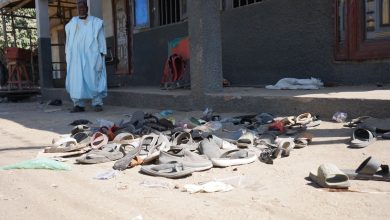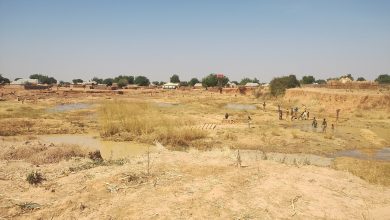Livestock Methane Emissions Fuels Climate Crisis In Northern Nigeria
While the livestock sector in Nigeria's North has been a significant driver of economic growth, it has also emerged as a major contributor to the nation's greenhouse gas emissions, worsening climate change challenges.

Dozens of cows mooed as Saad Jalo herded them over lush elephant grass, their tongues feasting greedily to fill their bellies. The herder supervised their movements to avoid encroachment on cultivated lands. Seeing that the cattle were unsatisfied, he guided them to another green pasture where they fed on guinea grass.
Jalo sat under a fig tree, his gaze sweeping across the surroundings to ensure that danger was not lurking around. His watchful eyes guarded the cows, about 40 of them, as they grazed peacefully on the Yorro landscape in Taraba, North East Nigeria.
During the lean, dry months, the 27-year-old sustained his cattle herd on meagre rations of beans, rice, maize, and sorghum residues while patiently waiting for the rainy season. When the rains descended in May, he herded the cattle into the forest for nourishing pasture and refreshing water.
He inherited his parents’ legacy of livestock stewardship. Fulani pastoralists commonly practise this tradition, passing it down through generations.
While this tradition has brought many economic blessings, the emissions from livestock rearing pose some threats to the climate. Ruminant animals, such as cattle, release substantial amounts of methane, a potent greenhouse gas (GHG), through digestion and manure decomposition. These emissions exacerbate global warming and climate change.
“The natural grasses result in low feed conversion efficiency and therefore increase enteric fermentation [the digestive process of breaking down food in a cow’s stomach], leading to methane production,” said Dr Usman Kolo, an Animal Science Lecturer at the University of Maiduguri (UNIMAID).
Jalo understands methane and its impact on climate change, but he admits that he is unaware that livestock, especially cattle, are a significant source of this greenhouse gas.
Globally, the agriculture sector accounts for about 44 per cent of methane emissions, with livestock rearing, particularly cattle and sheep, contributing 14.5 per cent to global warming. With more concentration on cattle rearing, the northern parts of Nigeria play a significant role in the country’s methane emissions profile. While livestock farming has brought crucial economic values, its contribution to climate change often goes unnoticed.
Nigeria contributed significantly to global agricultural emissions between 2015 and 2021, accounting for two per cent, according to Climate Trace, an independent GHG emissions tracker. Methane emissions totalled 20.3 million tonnes during this period. In 2021 alone, the country’s contribution rose to 4.9 per cent, with methane and nitrous oxide emitting 3.00 and 0.09 million tonnes, respectively.
Additionally, the latest mitigation analysis by Nigeria’s Federal Ministry of Environment shows that in 2018, greenhouse gas emissions were 347 metric tons of carbon dioxide equivalent, with Agriculture, Forestry, and Other Land Use (AFOLU) contributing 25 per cent—making it the second largest contributor.
The climate in northern Nigeria, characterised by semi-arid conditions, influences livestock farming practices and methane emissions. With an annual temperature of 29 degrees Celsius and a daily temperature of about 38 degrees Celsius, however, the often dry or hot weather exacerbates the decomposition of manure. Water scarcity also confines cattle to smaller areas, causing more manure and higher emissions.
“Some people make fire with cattle manure, while others use it as fertiliser. Years ago, it was used in the exterior decoration of houses,” Jalo told HumAngle. Other cattle rearers, such as Zakariyau Usman, 30, corroborated these observations, highlighting the heat generated by manure piles.
The UNIMAID lecturer confirmed that “the feeding and manure management techniques used in Northern Nigeria contribute significantly to methane emissions from livestock farming.” He noted that cattle diets consisting of natural grasses and crop residues lead to higher methane production than optimised feed blends in more developed farming systems.
Dr Kolo also remarked that traditional manure management practices, such as open-air storage or simple pits, create conditions that foster methane production. In contrast, advanced manure management techniques, like anaerobic digestion, which could significantly reduce methane emissions, are seldom used.
However, the United Nations Framework Convention on Climate Change (UNFCCC) encouraged nations to communicate emission inventories of greenhouse gases such as methane, nitrous oxide, and carbon dioxide from various sectors, including energy, agriculture, forestry, and municipal waste.
While methane emissions from livestock and sources like fossil fuels may not directly harm human health, they contribute to the formation of ground-level ozone, a harmful air pollutant. Experts say ozone can cause respiratory problems, aggravate asthma, and reduce lung function, posing significant health risks to local communities. Moreover, other pollutants associated with livestock farming can further degrade air quality.
Experts further warned that climate change driven by methane emissions disrupts local agricultural systems. Meanwhile, altered weather patterns, increased frequency of droughts, and reduced agricultural productivity threaten food security in Northern Nigeria.
“The forest is barren now compared to the past when there were edible tree leaves. Loggers and charcoal makers have cut down most of the trees, like baure [sycamore fig], madaci [mahogany], marke [african birch], et cetera,” Jalo complained. “We have to migrate deep into the forest before we can feed our cattle because most of the lands are farms.” He also complained about water scarcity, particularly during the dry seasons, recalling how he once clashed with a farmer.
Some climate and environment experts warned that changes in temperature and precipitation patterns can disrupt habitats, threaten species survival, and alter the composition of ecosystems. They said Northern Nigeria’s rich biodiversity, including its unique flora and fauna, is at risk from these climate-induced changes.
“The heatwaves experienced in recent times are a result of these methane gases because they have caused a greenhouse effect,” Usman Aliyu, an environmental activist in Borno state, explained, noting that this has seriously affected agricultural productivity. “It has altered the rainfall pattern over the years. We could hardly get a complete three months of rainfall compared to the past when there used to be at least four to five months of continuous rainfall. It has endangered biodiversity, causing the extinction of some plants and animals.”
However, researchers and academic institutions are exploring innovative solutions to reduce methane emissions in the region.
“We are presently researching the multi-variant impact of climate change on agricultural production in Borno state,” Aliyu said. “Some of our undergraduate research formulates diets for animals to reduce the amount of grain, which can reduce enteric fermentation,” Dr Kolo added.
Meanwhile, Nigeria seems committed to becoming a low-carbon economy to promote sustainable development and contribute to global efforts to reduce greenhouse gas emissions. In a 47-page report, the Federal Ministry of Environment stated that the country’s government has taken note of the urgent need for nationally based mitigation actions to contribute to the goal of keeping the global temperature below 1.5 degrees Celsius by 2030.
The country has outlined some key actions to achieve this goal, including increasing the availability of carbon sinks and reducing emissions in high-polluting sectors such as oil and gas, transport, mining, and manufacturing. However, effective implementation and enforcement remain vital challenges.
“Community-based approaches that involve farmers in decision-making processes and provide them with the knowledge and tools to adopt sustainable practices can lead to significant reductions in methane emissions,” said Aliyu on reducing methane emissions from livestock farming. “Programs that focus on capacity building, knowledge sharing, and access to resources are particularly effective. Professional environmental and waste managers should be employed to manage the wastes from livestock. There is a need to review and enforce environmental laws in the state [Borno]. Finally, the government should create a livestock layout or zone where farmers and herders can rear and graze their animals outside residential areas.”
Kolo corroborates his recommendations, adding that a balanced diet meets the animals’ natural requirements and that efficient manure management techniques capture and use methane gas for animal energy production.
“Feeding livestock with high-quality feeds and reducing the amount of grains in their diet will reduce methane emissions coming from enteric fermentation, implementation of manure management practices, selecting of animal species that produce less methane, and technological interventions such as methane capturing systems or biofilter that can capture and reduce methane emissions from livestock farming,” he said.
Support Our Journalism
There are millions of ordinary people affected by conflict in Africa whose stories are missing in the mainstream media. HumAngle is determined to tell those challenging and under-reported stories, hoping that the people impacted by these conflicts will find the safety and security they deserve.
To ensure that we continue to provide public service coverage, we have a small favour to ask you. We want you to be part of our journalistic endeavour by contributing a token to us.
Your donation will further promote a robust, free, and independent media.
Donate HereStay Closer To The Stories That Matter




